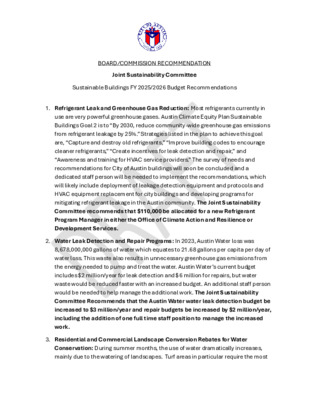7d. Sustainable Buildings Budget Recommendations - DRAFT — original pdf
Backup

BOARD/COMMISSION RECOMMENDATION Joint Sustainability Committee Sustainable Buildings FY 2025/2026 Budget Recommendations 1. Refrigerant Leak and Greenhouse Gas Reduction: Most refrigerants currently in use are very powerful greenhouse gases. Austin Climate Equity Plan Sustainable Buildings Goal 2 is to “By 2030, reduce community-wide greenhouse gas emissions from refrigerant leakage by 25%.” Strategies listed in the plan to achieve this goal are, “Capture and destroy old refrigerants,” “Improve building codes to encourage cleaner refrigerants,” “Create incentives for leak detection and repair,” and “Awareness and training for HVAC service providers.” The survey of needs and recommendations for City of Austin buildings will soon be concluded and a dedicated staff person will be needed to implement the recommendations, which will likely include deployment of leakage detection equipment and protocols and HVAC equipment replacement for city buildings and developing programs for mitigating refrigerant leakage in the Austin community. The Joint Sustainability Committee recommends that $110,000 be allocated for a new Refrigerant Program Manager in either the Office of Climate Action and Resilience or Development Services. 2. Water Leak Detection and Repair Programs: In 2023, Austin Water loss was 8,678,000,000 gallons of water which equates to 21.68 gallons per capita per day of water loss. This waste also results in unnecessary greenhouse gas emissions from the energy needed to pump and treat the water. Austin Water’s current budget includes $2 million/year for leak detection and $6 million for repairs, but water waste would be reduced faster with an increased budget. An additional staff person would be needed to help manage the additional work. The Joint Sustainability Committee Recommends that the Austin Water water leak detection budget be increased to $3 million/year and repair budgets be increased by $2 million/year, including the addition of one full time staff position to manage the increased work. 3. Residential and Commercial Landscape Conversion Rebates for Water Conservation: During summer months, the use of water dramatically increases, mainly due to the watering of landscapes. Turf areas in particular require the most water per square foot in any landscape. While ordinances for new construction can help reduce the amount of turf areas, existing properties don’t have requirements to adapt their landscapes to conserve water. Reducing the amount of turf grass that requires a lot of water to survive will help conserve water and reduce energy use needed for pumping and treatment. Austin Water should offer more substantial and accessible rebates for landscape conversions. Currently, Austin Water offers a landscape conversion rebate of $100 per 100 square feet, up to a maximum rebate of $3000. Most conversions will be smaller areas and thus, the currently offered rebate amounts don’t incentivize many customers to implement landscape conversions. In 2023, only 19 rebate applications were submitted to Austin Water. Austin Water should implement a tiered rebate structure that offers more rebate money for smaller areas of landscape conversion for residential properties and should substantially increase the maximum rebate offered. As suggested by the Get Fertilizer Wiser campaign, there should also be incentives that are more easily accessible to individuals who may not need to fully remove turf grass in order to reduce or eliminate watering. The Joint Sustainability Committee recommends increasing Austin Water’s Landscaping Conversion budget from $40,000/year to $150,000/year. 4. Solar Energy for City Facilities: Analysis by the Office of Climate Action and Resilience did an analysis of the financial costs and benefits of installing solar on City of Austin General Fund Buildings that shows that a $14 million investment in solar for those buildings would pay off in just over 6 years. Solar panels are generally warrantied for 25 years and can last much longer. The additional 19 years of warranted production would be worth about $43.3 million (assuming the current Value of Solar rate, which is going to go up next year). The Joint Sustainability Committee recommends that $14 million in certificates of obligation be allocated to install solar on City of Austin buildings, starting with General Fund Buildings. The resulting savings should be allocated to the Sustainability Revolving Fund that is envisioned as part of the Comprehensive Climate Implementation Program to fund other building improvements that reduce greenhouse gas emissions and/or conserve energy (including batteries).